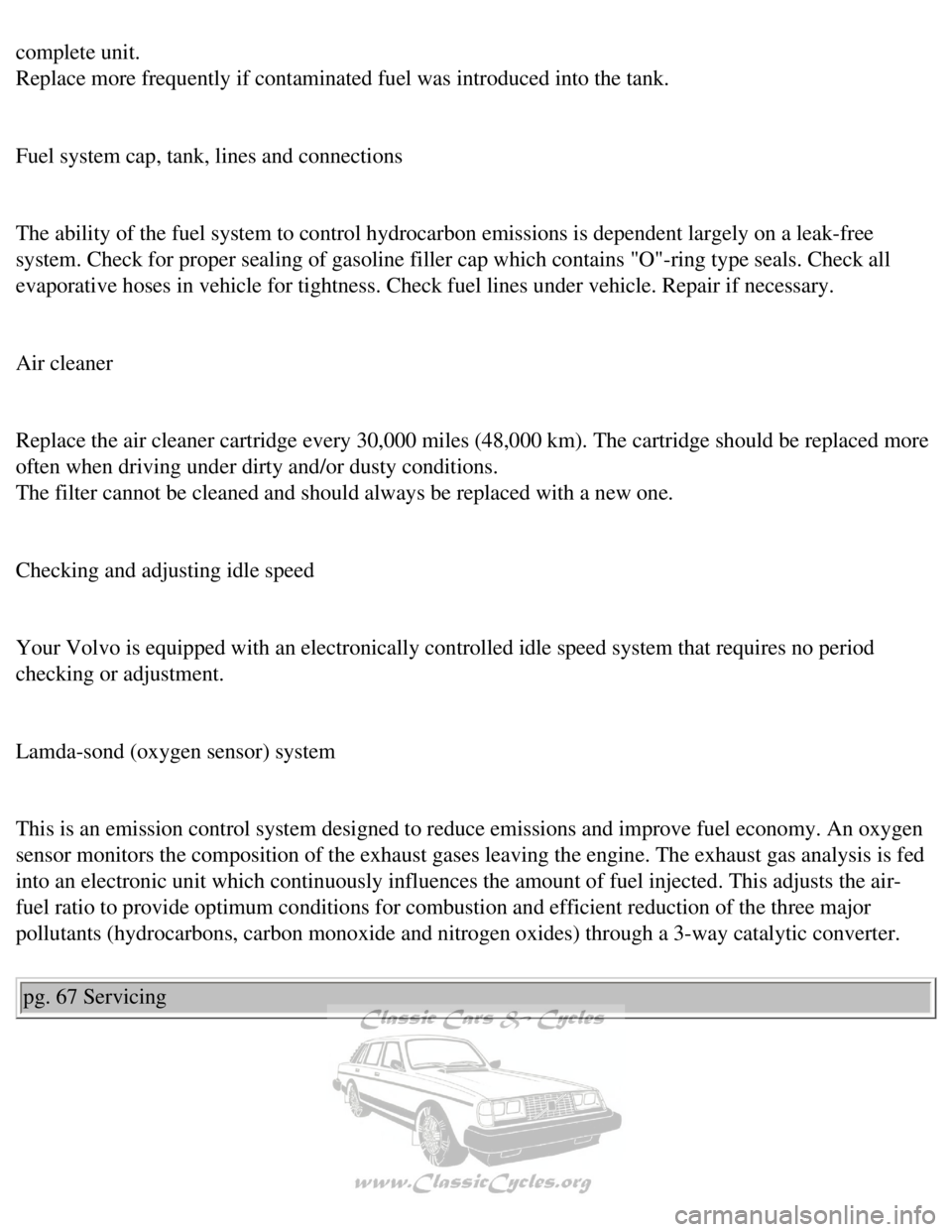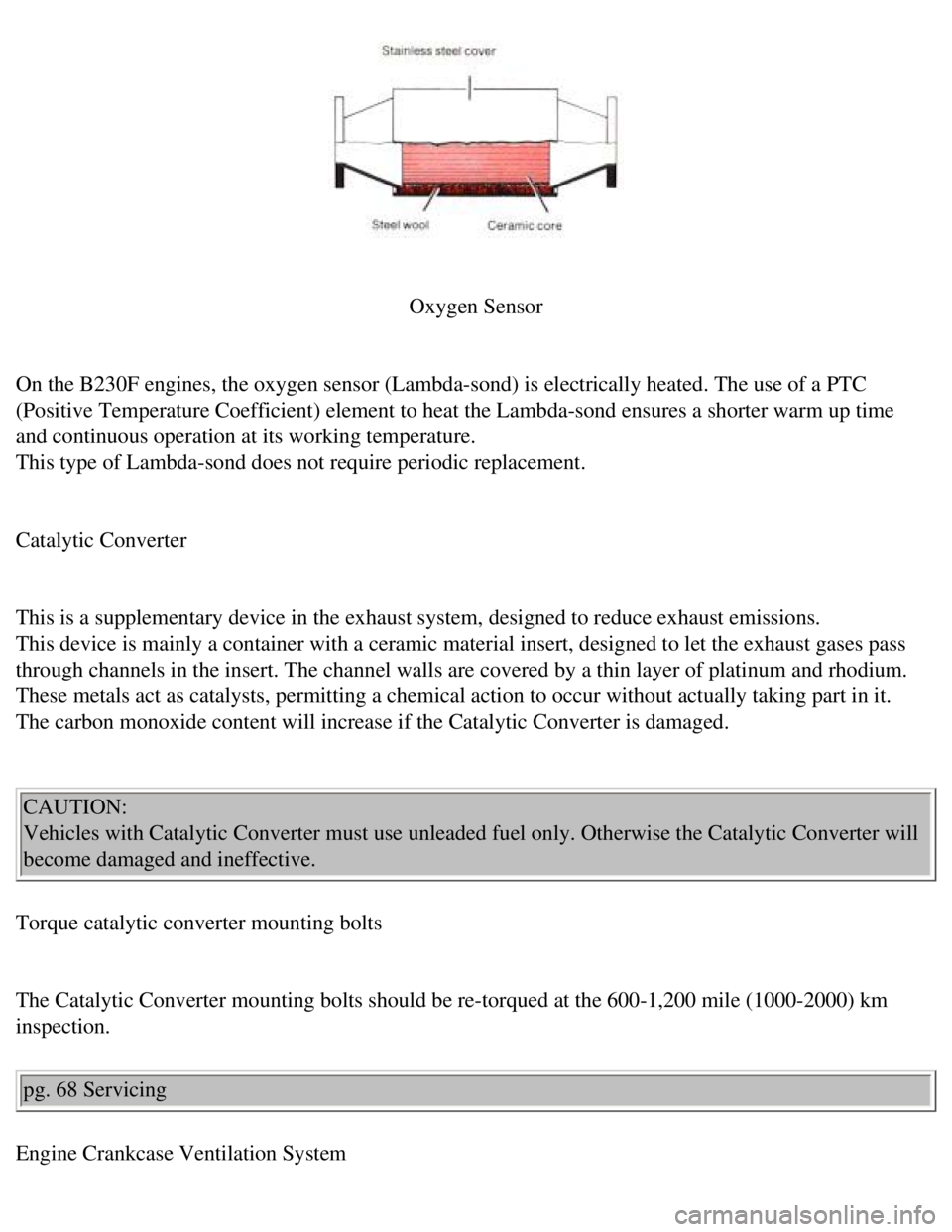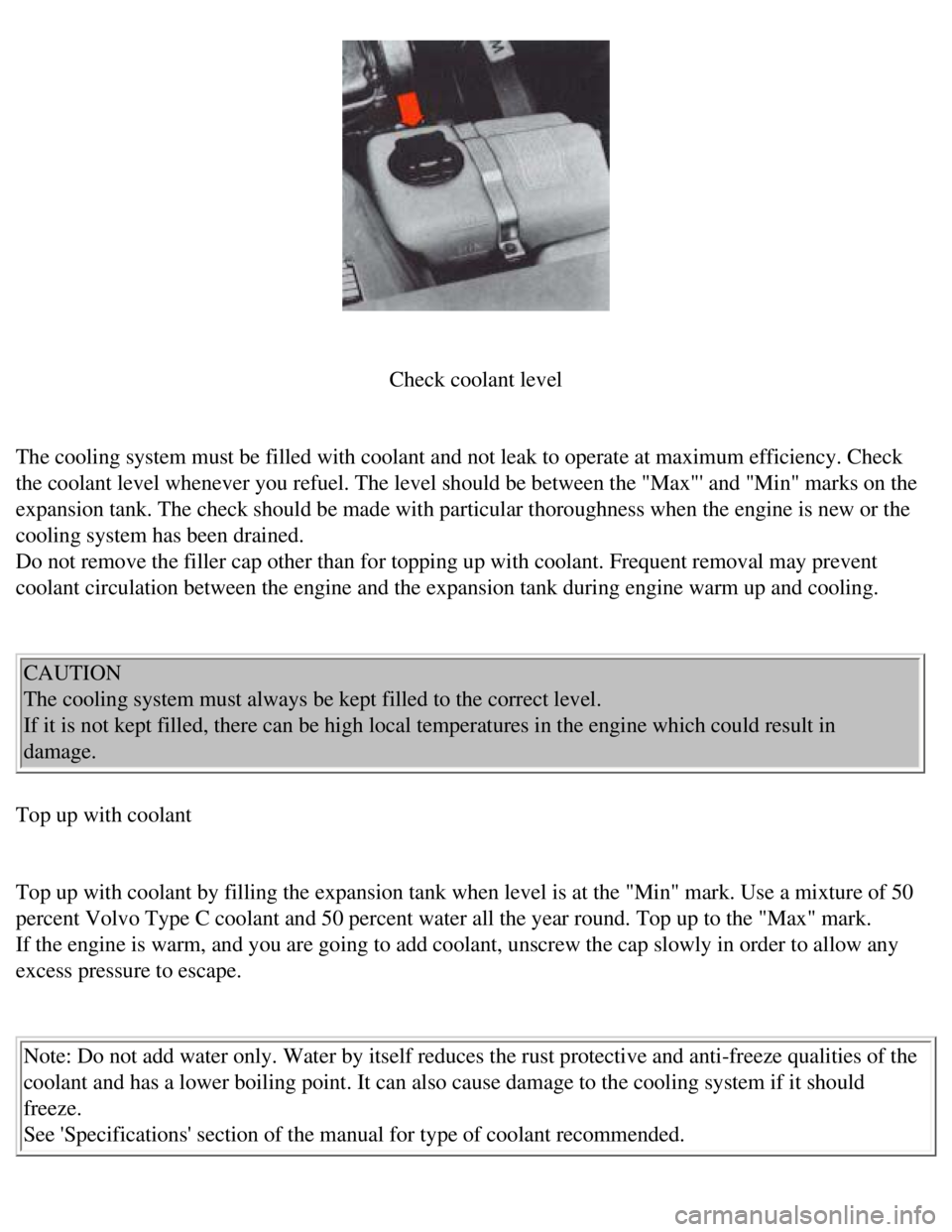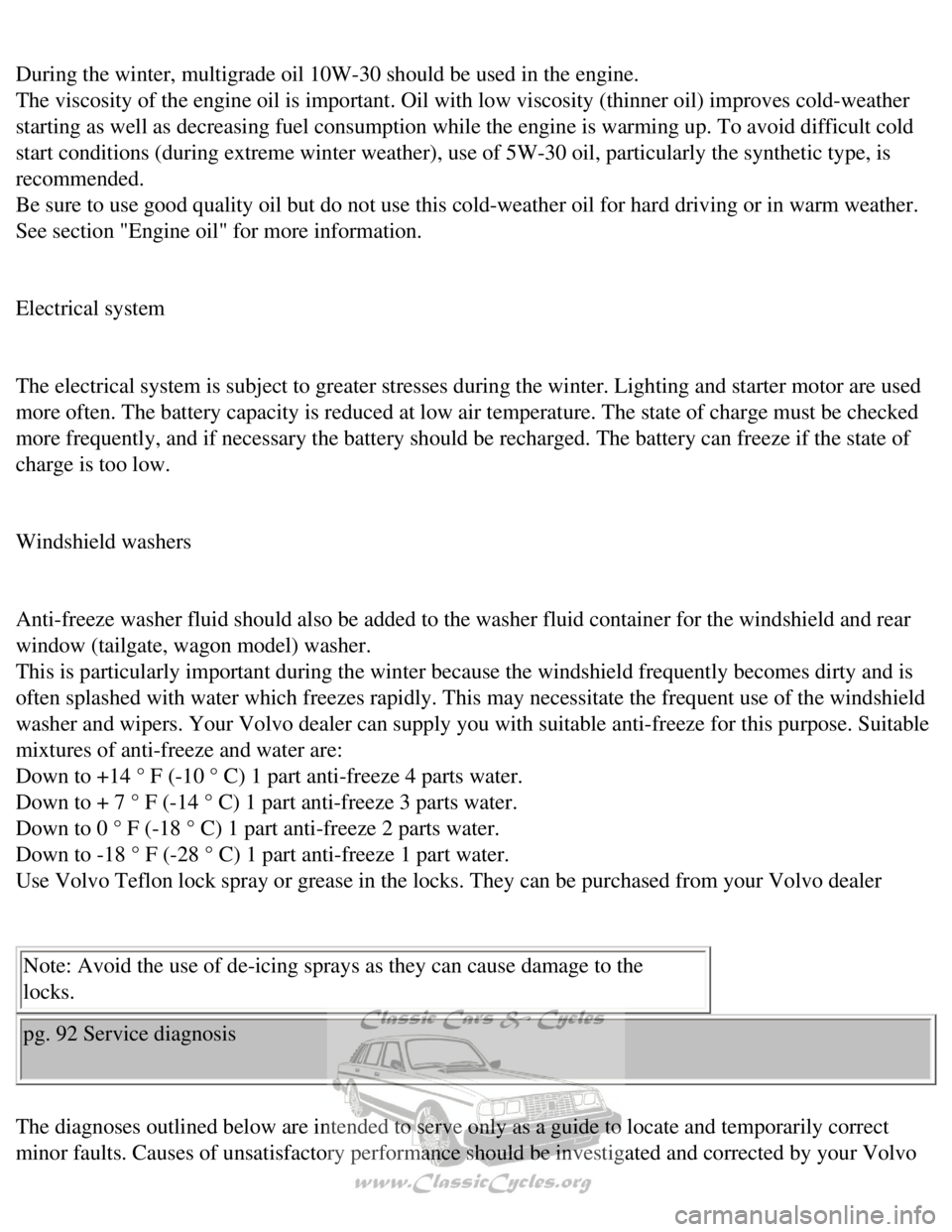1990 VOLVO 240 fuel type
[x] Cancel search: fuel typePage 80 of 143

Volvo 1990 240 Model
Checking oil level
The oil level should be checked each time the fuel tank is refilled. Be \
sure the oil level is maintained
between the upper and lower marks on the dipstick. Low oil level can cau\
se internal damage to the
engine and overfilling can result in high oil consumption. The distance \
between the dipstick marks
represents approx. 1 quart (1 liter) of oil.
Changing oil filter
Replace the oil filter at every oil change. If the oil filter is changed\
separately, 1/2 US qt = 1/2 liter of oil
should be added.
To add oil or change oil
Add oil of the same kind as already used. See engine oil section.
Note: Allow engine to cool before changing
oil.
Coolant
Maintain fluid level between MAX and MIN marks on expansion tank. Mixtur\
e of 50 percent Volvo
antifreeze type C (blue-green) or similar and 50 percent water should \
be used. See "Coolant" section.
file:///K|/ownersdocs/1990/1990_240/90240_13.htm (4 of 9)12/30/2006 8:\
25:08 AM
Page 88 of 143

Volvo 1990 240 Model
complete unit.
Replace more frequently if contaminated fuel was introduced into the tan\
k.
Fuel system cap, tank, lines and connections
The ability of the fuel system to control hydrocarbon emissions is depen\
dent largely on a leak-free
system. Check for proper sealing of gasoline filler cap which contains "\
O"-ring type seals. Check all
evaporative hoses in vehicle for tightness. Check fuel lines under vehic\
le. Repair if necessary.
Air cleaner
Replace the air cleaner cartridge every 30,000 miles (48,000 km). The \
cartridge should be replaced more
often when driving under dirty and/or dusty conditions.
The filter cannot be cleaned and should always be replaced with a new on\
e.
Checking and adjusting idle speed
Your Volvo is equipped with an electronically controlled idle speed syst\
em that requires no period
checking or adjustment.
Lamda-sond (oxygen sensor) system
This is an emission control system designed to reduce emissions and impr\
ove fuel economy. An oxygen
sensor monitors the composition of the exhaust gases leaving the engine.\
The exhaust gas analysis is fed
into an electronic unit which continuously influences the amount of fuel\
injected. This adjusts the air-
fuel ratio to provide optimum conditions for combustion and efficient re\
duction of the three major
pollutants (hydrocarbons, carbon monoxide and nitrogen oxides) through\
a 3-way catalytic converter. pg. 67 Servicing
file:///K|/ownersdocs/1990/1990_240/90240_14.htm (3 of 7)12/30/2006 8:\
25:08 AM
Page 89 of 143

Volvo 1990 240 Model
Oxygen Sensor
On the B230F engines, the oxygen sensor (Lambda-sond) is electrically \
heated. The use of a PTC
(Positive Temperature Coefficient) element to heat the Lambda-sond ens\
ures a shorter warm up time
and continuous operation at its working temperature.
This type of Lambda-sond does not require periodic replacement.
Catalytic Converter
This is a supplementary device in the exhaust system, designed to reduce\
exhaust emissions.
This device is mainly a container with a ceramic material insert, design\
ed to let the exhaust gases pass
through channels in the insert. The channel walls are covered by a thin \
layer of platinum and rhodium.
These metals act as catalysts, permitting a chemical action to occur wit\
hout actually taking part in it.
The carbon monoxide content will increase if the Catalytic Converter is \
damaged.
CAUTION:
Vehicles with Catalytic Converter must use unleaded fuel only. Otherwise\
the Catalytic Converter will
become damaged and ineffective.
Torque catalytic converter mounting bolts
The Catalytic Converter mounting bolts should be re-torqued at the 600-1\
,200 mile (1000-2000) km
inspection.
pg. 68 Servicing
Engine Crankcase Ventilation System
file:///K|/ownersdocs/1990/1990_240/90240_14.htm (4 of 7)12/30/2006 8:\
25:08 AM
Page 91 of 143

Volvo 1990 240 Model
Evaporative control systems
Vehicles intended for the North American market are equipped with a fuel\
vapor evaporative control
system, which prevents gasoline fumes from being released into the atmos\
phere.
The system is comprised of an expansion chamber in the fuel tank, a roll\
-over valve on the cross
member in front of the fuel tank, and a charcoal canister with built-in \
vacuum valve. The components
are interconnected by hoses which channel fuel vapor from the gas tank t\
o the charcoal filter where they
are stored until the engine is started and then drawn into the engine fu\
el induction system.
Engine Ignition
Change spark plugs
The spark plugs should be changed every 30,000 miles (48,000 km).
However, prolonged city driving or fast highway driving may necessitate \
changing spark plugs after
10,000 miles (16,000 km) of driving. When installing new plugs, be sur\
e to fit the right type and use the
correct torque, see "Specifications".
When changing the spark plugs, check that the suppressor connectors are \
in good condition. Cracked or
damaged connectors should be replaced.
When changing spark plugs, clean the cables and cable terminals, also th\
e rubber seals. If the car is
driven on roads where salt is used during the winter, coat the cables wi\
th silicone.
file:///K|/ownersdocs/1990/1990_240/90240_14.htm (6 of 7)12/30/2006 8:\
25:08 AM
Page 99 of 143

Volvo 1990 240 Model
Check coolant level
The cooling system must be filled with coolant and not leak to operate a\
t maximum efficiency. Check
the coolant level whenever you refuel. The level should be between the "\
Max"' and "Min" marks on the
expansion tank. The check should be made with particular thoroughness wh\
en the engine is new or the
cooling system has been drained.
Do not remove the filler cap other than for topping up with coolant. Fre\
quent removal may prevent
coolant circulation between the engine and the expansion tank during eng\
ine warm up and cooling.
CAUTION
The cooling system must always be kept filled to the correct level.
If it is not kept filled, there can be high local temperatures in the en\
gine which could result in
damage.
Top up with coolant
Top up with coolant by filling the expansion tank when level is at the "\
Min" mark. Use a mixture of 50
percent Volvo Type C coolant and 50 percent water all the year round. To\
p up to the "Max" mark.
If the engine is warm, and you are going to add coolant, unscrew the cap\
slowly in order to allow any
excess pressure to escape.
Note: Do not add water only. Water by itself reduces the rust protective\
and anti-freeze qualities of the
coolant and has a lower boiling point. It can also cause damage to the c\
ooling system if it should
freeze.
See 'Specifications' section of the manual for type of coolant recommend\
ed.
file:///K|/ownersdocs/1990/1990_240/90240_15.htm (7 of 10)12/30/2006 8\
:25:09 AM
Page 112 of 143

Volvo 1990 240 Model
Warning: Turn starting (ignition) switch OFF before replacing fuses. E\
xcessive heat may be created by
a short circuit. Care must be exercised while replacing blown fuses.
Some of the equipment listed below is optional
Refer to the fuse location chart at fuse box for fuses specific to your \
car.
1 Cigarette lighter, Power mirrors, Radio, Tailgate wiper/washer 8A
2 Windshield wiper/washer, Horn 16A
3 Heater blower 25A
4 Fuel feed (in-tank) pump, Lambda-sond heating element 8A
5 Turn signals, Back-up lights 16A
6 Main fuel pump relay 16A
7 Brake lights 8A
8 Central locking, Interior and glove compartment lights, Trunk and engi\
ne
compartment lights, Radio, Power antenna, Clock, Daytime running lights \
(Canada)* 8A
9 Hazard warning Flashers 8A
10 Power windows 16A
11 Heated rear window, 4th gear (automatic transmission) 16A
12 Air conditioning (with blower control), Power windows (relay),
Heated rear window (relay), Seat belt reminder, Cruise control 8A
13 Heated front seats, Daytime running lights - relay (Canada)* 16A
14 Rear fog lights 8A
15 Parking lights (left side), License plate light 8A
16 Parking lights (right side), Instruments and control panel lights, \
Shift indicator light 8A
Blade type fuse, serving LH-Jetronic fuel injection system. Located on t\
he left
wheel housing by the ignition coil 25A
* Note: Early production Canadian vehicles are not equipped with Daytime\
Running Lights.
Contents | Top of Page
file:///K|/ownersdocs/1990/1990_240/90240_16.htm (10 of 10)12/30/2006 \
8:25:10 AM
Page 123 of 143

Volvo 1990 240 Model
pg. 91 Long distance trips, Cold weather
Prior to a long distance trip
Have your car checked at a Volvo dealer. Preventive maintenance will hel\
p to ensure a trouble free trip.
Remember to take along a Volvo dealer directory.
The main items to check are listed below:
1. Brakes, front wheel alignment and steering gear.
2. Engine running condition.
3. Fuel system operation.
4. Oil leaks: engine, transmission, rear axle.
5. Cooling system for leaks or worn hoses.
6. Examine tires carefully, replace worn tires.
7. Battery and terminals.
8. Tool equipment.
9. Lighting.
10. Drive belts, for tightness and wear.
11. All fluid levels.
Cold weather/Engine fuel system
During the winter, large variations in temperature cause condensation to\
form in the fuel tank and can
impair the running of the engine. This can be reduced by adding dry gas \
to the fuel. There is less risk of
condensation forming in the fuel tank if it is kept full or nearly full.\
Engine cooling system
Volvo type C (blue-green) coolant should be used all year round. The c\
ooling system should always
contain water plus anti-freeze and rust inhibitor, even during the summe\
r. Experience has also shown
that extremely weak anti-freeze solutions (10-25 percent) are ineffect\
ive for rust protection. For this
reason, the quantity of antifreeze/summer coolant should be about 50 per\
cent of the solution. This
lowers the freezing point to - 30 ° F (-35 ° C).
Engine lubricating system
file:///K|/ownersdocs/1990/1990_240/90240_19.htm (1 of 7)12/30/2006 8:\
25:13 AM
Page 124 of 143

Volvo 1990 240 Model
During the winter, multigrade oil 10W-30 should be used in the engine. \
The viscosity of the engine oil is important. Oil with low viscosity (t\
hinner oil) improves cold-weather
starting as well as decreasing fuel consumption while the engine is warm\
ing up. To avoid difficult cold
start conditions (during extreme winter weather), use of 5W-30 oil, pa\
rticularly the synthetic type, is
recommended.
Be sure to use good quality oil but do not use this cold-weather oil for\
hard driving or in warm weather.
See section "Engine oil" for more information.
Electrical system
The electrical system is subject to greater stresses during the winter. \
Lighting and starter motor are used
more often. The battery capacity is reduced at low air temperature. The \
state of charge must be checked
more frequently, and if necessary the battery should be recharged. The b\
attery can freeze if the state of
charge is too low.
Windshield washers
Anti-freeze washer fluid should also be added to the washer fluid contai\
ner for the windshield and rear
window (tailgate, wagon model) washer.
This is particularly important during the winter because the windshield \
frequently becomes dirty and is
often splashed with water which freezes rapidly. This may necessitate th\
e frequent use of the windshield
washer and wipers. Your Volvo dealer can supply you with suitable anti-f\
reeze for this purpose. Suitable
mixtures of anti-freeze and water are:
Down to +14 ° F (-10 ° C) 1 part anti-freeze 4 parts water.
Down to + 7 ° F (-14 ° C) 1 part anti-freeze 3 parts water.
Down to 0 ° F (-18 ° C) 1 part anti-freeze 2 parts water.
Down to -18 ° F (-28 ° C) 1 part anti-freeze 1 part water.
Use Volvo Teflon lock spray or grease in the locks. They can be purchase\
d from your Volvo dealer
Note: Avoid the use of de-icing sprays as they can cause damage to the
locks.
pg. 92 Service diagnosis
The diagnoses outlined below are intended to serve only as a guide to lo\
cate and temporarily correct
minor faults. Causes of unsatisfactory performance should be investigate\
d and corrected by your Volvo
file:///K|/ownersdocs/1990/1990_240/90240_19.htm (2 of 7)12/30/2006 8:\
25:13 AM